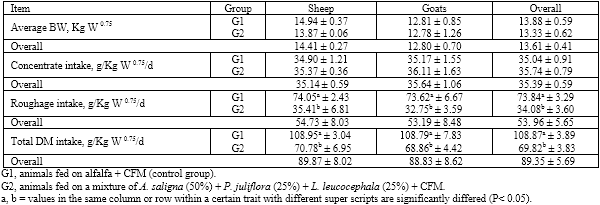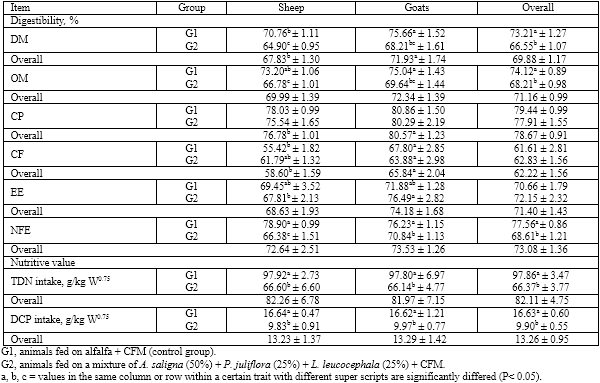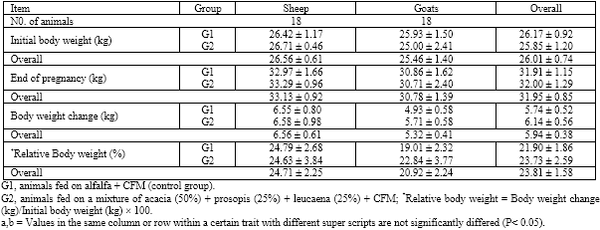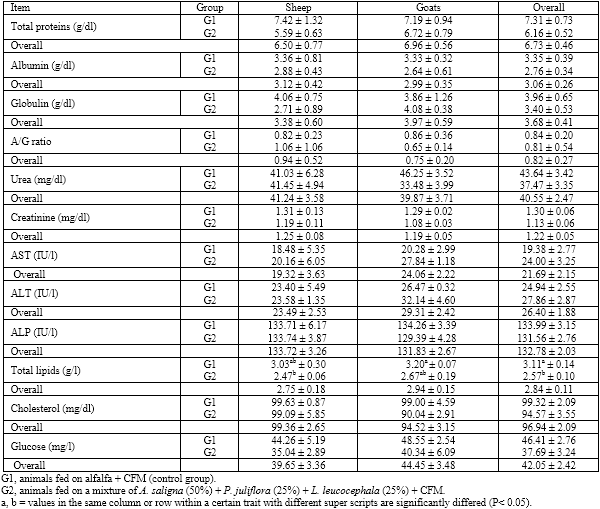Comparative nutritional studies of sheep and goats fed cultivated tree legumes mixture under desert condition
This research was performed to compare the nutritional studies of Barki sheep and doe Shami goats fed on mixture of forage tree legumes and its effects on feed intake, nutrient digestibility, nutritive value, nitrogen utilization, body weight change, some parameters of rumen and blood. Our study was carried out at South Sinai Research Station (Ras Suder), South Sinai Governorate, Egypt. Thirty-six pregnant Barki sheep and Shami goats were randomly allocated into two equal groups (18 animals each species). The first group (G1) of each species fed alfalfa with concentrate diet and served as control. The second group (G2) fed ad libitum sun-dried chopped mixture contained 50% Acacia saligna, 25% Prosopis juliflora and 25% Leucaena leucocephala with concentrate diet. Results indicated that overall roughage and total DM intake (g/Kg W 0.75/d) were similar between both species but animals fed G2 showed lower (P<0.05) in roughage and total DM intake than those fed G1. The results also showed that goats had higher (P<0.05) overall dry matter (DM), crud protein (CP) and crud fiber (CF) digestibility than sheep but overall nitrogen intake (NI) was similar between both species and was higher (P<0.05) for animals fed G1 vs. those fed G2. Also, nitrogen balance was similar between both species and was insignificant higher for those fed G1 vs. G2. Goats had higher (P<0.05) overall ammonia NH3-N than sheep but sheep had higher (P<0.05) overall ruminal TVFA´s than goats as well as animals fed G2 showed lower (P<0.05) NH3-N and TVFA´s than those fed G1. Values of body weight change (kg) and relative body weight (%) of end pregnancy were insignificant between both species and feeding treatments. Sheep had slightly insignificant lower concentrations of overall total protein and globulin than goats and was also slightly insignificant higher concentrations of overall urea and creatinine than goats while goats recorded insignificant higher values of overall AST and ALT than sheep. It was concluded feed utilization of tree legumes mixture as animal feeds in saline affected and soils could be an appropriate option for alleviating the desertification difficulties and provide alternatives as good feed resources especially in droughts when the other traditional food resources are shortage.
Key words: Sheep, goats, tree legumes, intake, digestibility, rumen parameters and blood parameters.

μ = Mean
Si = Effect of animal type, i, 1-2 (1=sheep, 2=goats)
Tj= Effect of roughage group, j, 1-2 (1=alfalfa and 2= tree legumes mixture)
STij = the interaction between animal type and of roughage group.
eijk = Experimental error








[1] El Shaer, H.M., 2015. Adaptation to climate change in decertified lands of the marginal regions in Egypt through sustainable crop and livestock diversification systems. Sciences in Cold and Arid Regions, 7 (1): 16-22.
[2] Makkar, H.P.S., 2003. Effects and fate of tannins in ruminant animals, adaptation to tannins, and strategies to overcome detrimental effects of feeding tannin-rich feeds. Small Ruminant Research, (49): 241-256.
[3] El-Shaer, H.M., 2010. Halophytes and salt-tolerant plants as potential forage for ruminants in the Near East region. Small Ruminant Research, 91: 3-12.
[4] Ben Salem, H., H. Nefzaoi, L. Ben Salem and J. Tisserand, 1999. Intake, digestibility, urinary excretion of purine derivatives and growth by sheep given fresh, air-dried or polyethlene glycolsoaked foliage of acacia cynophylla Land. J. Anim. Feed Sci. Technol., pp: 297-311.
[5] Safinaz, M.S., M.H. Ahmed and M.A. Ibrahim, 2010. Impact of feeding atriplex halimus and acacia saligna with different sources of energy on lambs performan. Egyptian J. Sheep Goat Sci., 5(1): 191-208.
[6] Moujahed, N., C. Kayoulib, A. Thewis, Y. Beckers and S. Rezgui, 2000. Effect of multinutrient blocks and polythylene glycol 4000 supplies on intake and digestion by sheep fed Acacia cyanophylla lindl. foliage based diets. J. Anim. Feed Sci. Technol., pp: 219-238.
[7] Moujahed, N., H. Ben Salem and C. Kayouli, 2005. Effects of frequency of polyethylene glycol and protein supplementation on intake and digestion of Acacia cyanophylla Lindl. foliage fed to sheep and goats. Small Rumin. Res., 56: 65-73.
[8] Shumuye, B. and T. Yayneshet, 2011. Effect of feeding treated Acacia Saligna (Labill.) H.L. Wendl. leaves on growth performance and digestibility in goats. J. Dryland Agric. 4(2): 341-347.
[9] Abdulrazak, S.A., T. Fujihara, J.K. Ondiek and E.R. Orskov, 2000. Nutritive evaluation of some Acacia tree leaves from Kenya. Animal Feed Science and Technology, 85: 89-98.
[10] Chaturvedi, O.H. and A. Sahoo, 2013. Nutrient utilization and rumen metabolism in sheep fed Prosopis juliflora pods and Cenchrus grass. Springer Plus, 2: 598.
[11] Sawal, R.K., R. Ratan and S.B.S. Yadav, 2004. Mesquite (Prosopis juliflora) Pods as a Feed Resource for Livestock- A Review. Asian Australas J Anim Sci., 17: 719-25.
[12] Pandya, P.R., G.R. Patel, R.S. Gupta, D.C. Patel, M.B. Pande and M.C. Desai, 2005. Effect of Wheat straw based total mixed ration with Prosopis juliflora pods (Mesquite pods) on performance of lactating cows. Inte J Cow Sci., 1: 66-72.
[13] Sharma, V., G.R. Purohit, R.S. Arya and M. Harsh, 2006. Evaluation of some complete rations in sheep incorporating unconventional feed resources of arid zone of India. Anim Nutr Feed Technol., 6: 135-141.
[14] Talpada, P.M., P.R. Pandya, G.R. Patel, D.C. Patel and M.C. Desai, 2002. Utilization of complete feds using Prosopis juliflora pods as a ration of growing crossbred calves. Indian J. Anim. Nutr. 19: 1-6.
[15] Aregheore, E.M., 1999. Nutritive and anti-nutritive value of some tree legumes used in ruminant livestock nutrition in Pacific Island countries. J South Pacific Agric, 6: 50-61.
[16] Barros-Rodríguez, M., J. Solorio-Sánchez and C. Sandoval-Castro, 2013. Effects of two intake levels of Leucaena leucocephala on rumen function of sheep. Trop Grassl Forrajes Tropicales, 1: 55-7.
[17] Nguyen, T.T.G., M. Wanapat, K. Phesatcha and S. Kang, 2017. Effect of inclusion of different levels of Leucaena silage on rumen microbial population and microbial protein synthesis in dairy steers fed on rice straw Asian-Australas J Anim Sci., pp: 1-6.
[18] Anbarasu, C., N. Dutta and K. Sharma, 2001. Use of leaf meal mixture as a protein supplement in the ration of goats fed wheat straw. Anim. Nutr. Feed Technol., 1: 113-123.
[19] Patra, A.K., K. Sharma, N. Dutta and A.K. Pattanaik, 2002. Effect of partial replacement of dietary protein by a leaf meal mixture containing Leucaena leucocephala, Morus alba and Azadirachta indica on performance of goats. Asian-Aust. J. Anim. Sci., 5 (12): 1732-1737.
[20] Kearl, I.C., 1982. Nutrients requirements in developing countries. Utah Agric. Exp. Stat., Utah State University, Logan, USA.
[21] AOAC., 2000. Official methods of analysis. 17th ed. Association of Official nalytical Chemists, Washington, DC, USA.
[22] Warner, A.C.J., 1964. Production of volatile fatty acids in the rumen methods of measurements Nutr. Abst. and Rev., 34: 339.
[23] Gornal, A.C., C.J. Bardawill and M.M. David, 1949. Kit Protein Egyptian American Co. for Laboratory Services. J. Biol. Chem., 177: 751-755.
[24] Doumas, B.T., W.A. Watson and H.G. Biggs, 1971. Albumin standards and the measurement of serum albumin with bromcresol green. Clinca Chemica Acta, 31: 87- 96.
[25] Schmit, J.M., 1964. Thesis, Lyon.
[26] Roeschlau, P., E. Bernt and W. Gurber, 1974. Enzymatic determination of total cholesterol in serum. Zklin. Chem. Klin. Biochem., 12(5): 226.
[27] Tietz, N.W., 1986. Textbook of Clinical Chemistry. W. B. Saunders Co. London, Philadelphia, pp: 796.
[28] Reitman, S.M.D. and S. Frankel, 1957. A colorimeter method for determination of serum glutamic oxaloacetic acid and glutamic pyruvic acid transferees. Am. J. Clin. Path., 28: 56-63.
[29] Belfield, A. and D.M. Goldberg, 1971. Revised assay for serum phenyl phosphayatase activity using 4- amino- antipyrine. Enzyme., 12: 561- 573.
[30] Fawcett, J.K. and J.E. Soctt, 1960. A rapid precise method for the determination of urea. J. Cline., Path., 13: 156.
[31] Schirmeister, J., H. Willmann, H. Kiefer and W. Hallauer, 1964. Fuer und wider die brauchbarkeit der endogenen hrea tininclearance der fanktionellen nierendiagnostik. Dtsch. Med. Woschr, 89 (9): 1640-1647.
[32] SAS Institute, 2004. Statistical Analysis System, STAT/ user’s guide, Release 9.1, SAS Institute, Cary NC. USA.
[33] Duncan, D.B., 1955. Multiple range and multiple F- test. Biometris, 11: 1-42.
[34] Salem, A., M. Salem, M. El-Adawya and P. Robinson, 2006. Nutritive evaluations of some browse tree foliages during the dry season: Secondary compounds, feed intake and in vivo digestibility in sheep and goats. Anim. Feed Sci. Technol., pp: 251-267.
[35] Food Agriculture Organization (FAO), 1992. Legume trees and other fodder trees as protein sources for livestock In: Speedy, A., Pugliese, P.L. (Eds.), Proceedingsd of the FAO Expert Consultation.
[36] Topps, J.H., 1992. Potential, composition and use of legume shrubs and trees as fodder for livestock in the tropics. J. Agric. Sci. Camb., 118: 1-8.
[37] Ben Salem, H., A. Nefzaoui, H. Makkarb, H. Hochlef, I. Ben Salem and L. Ben Salem, 2005a. Effect of early experience and adaptation period on voluntary intake, digestion, and growth in Barbarine lambs given tannin-containing (Acacia cyanophylla Lindl. Foliage) or tannin-free (Oaten hay) diets. J. Animal Feed Sci. Technol., pp: 59-77.
[38] Abdel-Fattah, Z.S., 2005. Impact of season of harvest on in vitro gas production and dry matter degradability of Acacia saligna leaves with inoculum from three ruminant species. Anim. Feed Sci. Technol., pp: 67-79.
[39] El Hag, M.G. and K.M. Al Shargi, 1998. Comparative Performance of Goats and Sheep Fed on High-fiber Pelleted Diets Supplemented with Different Nitrogen Sources. J. Appl. h i m. Res., 13: 179-184.
[40] Nefzaoui, A., H. Ben Salem, H. Abdouli and H. Ferchichi, 1993. Palatability of some Mediterranean shrubs. Comparison between browsing time and bacteria technique. In: FAO/CIHEAMWorkshop on Sheep and Goats Nutrition, Thessaloniki, Greece, pp: 99-109.
[41] Bartolom´e, J., J. Franch, J. Plaixats and N.G. Seligman, 1998. Diet selection by sheep and goats on Mediterranean heath woodland range. J. Range Manage. 51: 383-391.
[42] Rogosic, J., J.A. Pfister, F.D. Provenza and D. Grbesa, 2006. Sheep and goat preference for and Rome, Italy, Pp: 32-93.
[43] Ben Salem, H., I. Ben Salem and M.S. Ben Said, 2005. Effect of the level and frequency of PEG supply on intake, digestion, biochemical and clinical parameters by goats given kermes oak (Quercus coccifera L.)-based diets. Small Rumin. Res., 56: 127-137.
[44] Ben Salem, H. and T. Smith, 2008. Feeding strategies to increase small ruminant production in dry environments. Small Ruminant Res., 77: 174-194.
[45] Agrawal1, A.R., S.A. Karim, A. Rajiv Kumar, Sahoo and P.J. John, 2014. Sheep and goat production: basic differences impact on climate and molecular tools for rumen microbiome study. Int. J. Curr. Microbiol. App. Sci., 3 (1): 684-706.
[46] Silanikove, N., N. Gilboa, I. Nir, A. Perevolotsky and Z. Nitsan, 1996. Effect of a daily supplementation of polyethylene glycol on intake and digestion of tannin-containing leaves (Quercus calliprinos, Pisticia lentiscus and Ceratonia siliqua) by goats. J. Agric. Food Chem., 44: 199-205.
[47] Santra, A., S.A. Karim, A.S. Mishra, O.H. Chaturvedi and R. Prasad, 1998. Rumen ciliate protozoa and fiber utilization in sheep and goats. Small Rumin. Res., 30: 13-18.
[48] Min, B.R., T.N. Barry, G.T. Attwood and W.C. Mcnabb, 2003. The effect of condensed tannins on the nutritive and health of ruminants fed fresh temperate forages: a review. Animal Feed Science and Technology, 106 (1-4): P. 3-19.
[49] Mlambo, V., U. Marume and C.S. Gajana, 2015. Utility of the browser’s behavioural and physiological strategies in coping with dietary tannins: Are exogenous tannin inactivating treatments necessary. South African Journal of Animal Science., 45 (5): 441-451.
[50] Ortiz, L.T., C. Centeno and J. Tervino, 1993. Tannins in faba bean seeds: effect on the digestion of protein and amino acids in growing chicks. Animal Feed Science and Technology, 41: 271- 278.
[51] Streeter, M.N., G.M. Hill, D.G. Wagner, F.N. Owens and C.A. Hibberd, 1993. Effect of bird resistant and non bird resistant sorghum gain on amino acid digestion by beef heifers. J. Anim. Sci., 71: 1648- 1656.
[52] El-Meccawi, S., M. Kam, A. Brosh and A.A. Degen, 2008. Heat production and energy balance of sheep and goats fed sole diets of Acacia saligna and Medicago sativa. Small Rumin. Res., 75: 199-203.
[53] Reed, J.D., H. Soller and A. Woodward, 1990. Fodder tree and straw diets for sheep: intake, growth, digestibility and the effects of phenolics on nitrogen utilisation. Anim. Feed Sci. Technol., 30 (1-2): 39-50.
[54] Ben Salem, H., A. Nefzaoui, L. Ben Salem and J.L. Tisserand, 1997. Intake, digestibility in sheep given fresh or air-dried Acacia cynophylla Lindl. foliage. Ann. Zootech, 46: 361-374.
[55] Egea, A.V., L.I. Allegretti, S.A. Paez Lama, D.J. Grilli, M. Fucili, J.C. Guevara and J.J. Villalba, 2016. Diet mixing and condensed tannins help explain foraging preferen cesby Creole goats facing the physical and chemical diversity of native woody plants in the central Monte desert (Argentina). Animal Feed Science and Technology, 215: 47-57.
[56] Ndemanisho, E.E., L.A. Mtenga, E.F.C. Kimbi, A.E. Kimambo and E.J. Mtengati, 1998. Substitution of dry Leucaena leucocephala (DLL) for cotton seed cake (CSC) as a protein supplement to urea treated maize stover fed to dairy weaner goats. Anim. Feed Sci. Technol., 73: 365-374.
[57] Foroughbakhch, R., J.L. Hernández-Piñero, A. Carrillo-Parra, and A. Rocha-Estrada, 2013. Composition and animal preference for plants used for goat feeding in semiarid northeastern México. Journal of Animal and Plant Sciences, 23 (4): 1034-1040.
[58] Gihad, E.A., T.T.L. El gallad, A.E. Sooud, H.M. Abou El-Nasr and M.F.A. Farid, 1989. Feed and water intake, digestibility and nitrogen utilization by camels compared to sheep and goats fed low protein desert by-products Ciheam-Options Mediterraneennes Ser. Seminaries, 2: 75-81.
[59] Gihad, E.A., 1976. Intake, digestibility and nitrogen utilization of tropical natural grass hay by goats and sheep. J. Anim. Sci., 43: 879-883.
[60] Ferreira, A.V., L.C. Hoffman, S.J. Schoman and R. Sheridan, 2002. Water intake of Boer goats and Mutton merinos receiving either a low or high energy feedlot diet. Small Rumin. Res., 43: 245-248.
[61] Hadjigeorgiou, I.E., I.J. Gordon and J.A. Milne, 2003. Intake, digestion and selection of roughage with different staple lengths by sheep and goats. Small Rumin. Res., 47: 117-132.
[62] Van, D.T.T., 2006. Some Animal and Feed Factors Affecting Feed Intake, Behaviour and Performance of Small Ruminants doctoral thesis Swedish University of Agricultural Sciences Uppsala .ISSN 1652-6880, ISBN 91: 576-7081-1.
[63] Farid, M.FA., H.M. Abou El-Nasr and N.I. Hassan, 1986. Effect of dietary available carbohydrate level on feed and nitrogen utilization in sheep given urea in the drinking water. World Rev. of animal Prod., 12: 3.
[64] Domingue, B.M.F., D.W. Dellow and T.N. Barry, 1991. Voluntary intake and rumen digestion of low-quality roughage by goats and sheep. J. Agric. Sci., 117: 111-120.
[65] McSweeney, C.S., B. Palmer, R. Bunch and D.O. Krause, 1999. Isolation and characterization of Mediterranean heath woodland range. J. Range Manage, 51: 383-391.
[66] Szumacher-Strabel, M. and A. Cieslak, 2010. Potential of phytofactors to mitigate rumen ammonia and methane production. J. Anim. Feed Sci., 19: 319-337.
[67] Carro, M.D., G. Cantalapiedra-Hijar, M.J. Ranilla and E. Molina-Alcaide, 2012. Urinary excretion of purine derivatives, microbial protein synthesis, nitrogen use, and ruminal fermentation in sheep and goats fed diets of different quality J. Anim. Sci., 90: 3963-3972.
[68] Goel, G. and H.P.S. Makkar, 2012. Methane mitigation from ruminants using tannins and saponins, a status review. Trop. Anim. Health Prod., 44: 729-739.
[69] Aschenbach, J.R., G.B. Penner, F. Stumpff and G. Gabel, 2011. Ruminant nutrition symposium: role of fermentation acid absorption in the regulation of ruminal pH. J. Anim. Sci., 89: 1092-1107.
[70] Brown, D., J.W. Ngambi and D. Norris, 2017. Effect of tanniniferous Acacia karroo leaf meal inclusion level on feed intake, digestibility and live weight gain of goats fed a Setaria verticillata grass hay-based diet Journal of Applied Animal Research (Online) Journal homepage: http://www.tandfonline.com/loi/taar20.
[71] Zarkawi, M., M.R. Al-Masri and K. Khalifa, 2005. Nutritive value of Sesbania aculeate grown on salty soil and its effect on reproductive parameters of Syrian Awassi ewes. Aust. J. of Anim. Res., 56(8): 819-825.
[72] Shiroma, S. and A. Akashi, 1976. Degradation of mimosine in Leucaena leucocephala de Wit by goal rumen microorganisms. Nippon Chikusan Gakkai-ho; 47: 739- 747.
[73] Srivastavam, S.N.L. and K. Sharma, 1998. Response of goats to pelleted diets containing different proportions of sun-dried Leucaena leucocephala. Small Ruminant Research, 28: 139-148.
[74] Fayed, A.M., K.M. Youssef and H.M. Abou-El-Naser, 2001. Nutritional performance of goat fed non-conventional diets based on olive pulp in Sinai. Egyptian: Nutrition and Feeds, 1: 81-89.
[75] Mousa, M.R.M. and H.M. El-Shabrawy, 2003. Growth performance of Damascus kids as affected by feeding system under Semi-arid conditions of North Sinai. J. Agric. Sci. Mansoura Univ, 28(7): 5224-5237.
[76] Mehrez, A.Z., M.R.M. Mousa and H.M. El-Shabrawy, 2011. Effect of feeding varying levels of acacia leaves and twigs on productive performance of Awassi Ewes under Semi-arid conditions of north Sinai. Egyptian J. Nutrition an feeds, 14 (1): 39-52.
[77] Badawy, M.T., H.A. Gawish and A.A. Younis, 2002. Some physiological responses of growing Barki lambs and Baladi kids fed natural desert shrubs. International Symposium on Optimum Resources Utilization in Salt-Affect Ecosystems in Arid and Semi- arid Regions. Cairo, pp: 496-503.
[78] Abdel-Halim, A.M., 2003. Studies of some anti- nutritional factors affecting utilization by ruminants. Ph. D. thesis, Faculty of Science. Ain Shams University.
[79] Shaker, Y.M., S.S. Abou El-Ezz and A.L. Hashem, 2008. Physiological performance of Barki male lambs fed halophytes under semi-arid conditions. J. Agric. Sci. Mansoura Univ., 33 (9): 6393-6408. 21
[80] Shaker, Y.M., N.H. Ibrahim, F.E. Younis and H.M. El Shaer, 2014. Effect of Feeding Some Salt Tolerant Fodder Shrubs Mixture on Physiological Performance of Shami Goats in Southern Sinai, Egypt Journal of American Science., 10 (2s): 66-77.
[81] Azamel, A.A., 1997. Physiological responses and daily gain of growing Barki lambs fed on Atriplex halimus, a natural desert shrubs. Egypt. J. Appl. Sci., 12 (2): 1-9.
[82] Tripathy, K.C., B.K. Sahu, N.C. Panda and B.C. Nayak, 1984. Toxicity of tannin acid in goats. Indian J. Anim. Sci., 54 (11): 1091-1093.
[83] Bravo, L., E. Manas and F.S. Calixto, 1993. Dietary non extractable condensed tannins as indigestible compound: Effect on fecal weight and protein and fat excretion. J. Sci. Food Agric., 63: 63-68.
[84] Romero, M.J., J. Madrid, F. Hernandez and J.J. Ceron, 2000. Digestibility and voluntary intake of Vine leaves (Vitis vinifera L.) by sheep. Small Ruminant Res., 38: 191-195.






.jpg&w=3840&q=75)